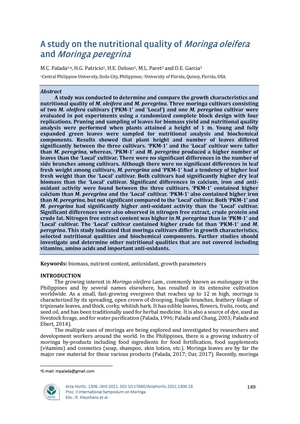The role of Moringa oleifera in agro-ecosystems: A review
| dc.contributor.author | Palada, Manuel C. | |
| dc.date.accessioned | 2022-06-29T07:49:37Z | |
| dc.date.available | 2022-06-29T07:49:37Z | |
| dc.date.issued | 2021-03 | |
| dc.identifier.citation | Palada, M. C. (2021). The role of Moringa oleifera in agro-ecosystems: A review. In Kleynhans, R. , Laurie, S. M. , Chimuka, L. K. & du Toit, E. S. (Eds)., II International Symposium on Moringa (pp. 83-97). International Society for Horticultural Science. https://doi.org/10.17660/ActaHortic.2021.1306.11 | en_US |
| dc.identifier.isbn | 978-94-62613-05-8 | |
| dc.identifier.issn | 0567-7572 | |
| dc.identifier.uri | https://hdl.handle.net/20.500.12852/2117 | |
| dc.description | Conference paper | en_US |
| dc.description.abstract | Moringa has been grown and cultivated in various agro-ecosystems ranging from small-scale backyard home gardens to large scale commercial production in tropical and sub-tropical agro-climatic ecosystems. It is grown in monoculture, mixed cropping such as intercropping, hedgerow intercropping or alley cropping system. In monoculture system, moringa is grown either for leaf production or seed production. High density monoculture planting of moringa is a cropping system mainly for maximum leaf biomass production. In mixed cropping systems, moringa is intercropped with high value crops such as vegetables and herbs. As a component of diverse agro-ecosystems moringa play a significant role including soil erosion control in sloping agricultural landscapes and carbon sequestration minimizing the consequences of climate change and global warming. In agroforestry systems, moringa is an important crop component which contributes to increasing soil fertility, soil moisture conservation and increased agro-economic returns. Although it is not a preferred tree species by agroforesters, it plays an important role in deforestation because of its ability to thrive in wastelands and provide rapid shade cover a better choice for many tree-planting projects. It is also a good nurse crop for slower-growing species that eventually will dominate the site. This paper presents a review of the significant role of moringa in agroecosystem and agro-industry based on studies conducted over the last 2 to 3 decades. | en_US |
| dc.language.iso | en | en_US |
| dc.publisher | International Society for Horticultural Science | en |
| dc.relation.ispartofseries | ISHS Acta Horticulturae;1306 | en |
| dc.subject.lcsh | Moringa oleifera | en_US |
| dc.subject.lcsh | Moringa | en_US |
| dc.subject.lcsh | Forest ecology | en_US |
| dc.subject.lcsh | Agroforestry | en_US |
| dc.subject.lcsh | Cropping systems | en_US |
| dc.subject.lcsh | Multiple cropping | en_US |
| dc.subject.lcsh | Climatic changes | en_US |
| dc.subject.lcsh | Global warming | en_US |
| dc.title | The role of Moringa oleifera in agro-ecosystems: A review | en_US |
| dc.type | Conference paper | en_US |
| dcterms.accessRights | Limited public access | en_US |
| dc.citation.firstpage | 83 | en_US |
| dc.citation.lastpage | 97 | en_US |
| local.subject | Agroecosystem | en_US |
| local.subject | Agroforestry | en_US |
| local.subject | Climate change | en_US |
| local.subject | Global warming | en_US |
| local.subject | Cropping systems | en_US |
| local.subject.scientificname | Moringa | en_US |
| local.subject.scientificname | Moringa oleifera | en_US |
| dc.identifier.doi | 10.17660/ActaHortic.2021.1306.11 | |
| dc.citation.conferencetitle | II International Symposium on Moringa | en_US |
| dc.identifier.essn | 2406-6168 |
Files in this item
| Files | Size | Format | View |
|---|---|---|---|
|
There are no files associated with this item. |
|||




